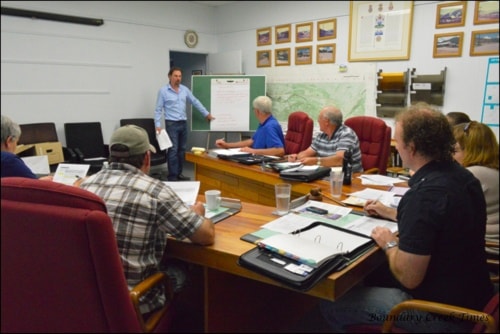Richard Toperczer helped Midway council revisit their five-year-old economic development plan for the village last week.
Things have changed in five years since 2009 when the Village of Midway adopted their economic development plan and the council felt it was time to give it a tune up.
After all, the name Vaagen didn’t appear anywhere in the earlier plan; and the goal of building a highway rest stop had been dropped when the full costs became known.
So they called in Richard Toperczer, regional manager of regional economic operations at the Vernon office of the Ministry of Jobs, Tourism and Skill Training and Responsible for Labour.
They met on Wednesday, June 4 to go through the revision process. Everyone had taken time to review the 2009 plan prior to the two and a half hour meeting and at the outset it was agreed to work toward having the revision completed by the end of the evening.
They began by sorting action items from the old plan into those that had been completed, those that were still relevant and those that were no longer pertinent.
Toperczer asked council, “What are you proud of?”
And they were able to name several achievements that have been realized in the village over the past five years—some by council itself, others that had been carried out by resident volunteers and other partners.
The list included: sawmill and Vaagen, community forest application, walking and hiking trails, museum upgrade to caboose, revitalization bylaw, amenities to support economic development, emergency service retention, Riverfront Park, new signs on highway, arena upgrades, agricultural use of airport, village beautification, wireless via Shaw-Go WiFi, stabilized local economy, participation in regional chamber of commerce, community garden, and the food prep kitchen.
It was agreed that a plan was needed to advertise these accomplishments and specific individuals were assigned to make that happen. That was a major change from the former economic development plan, which had assigned specific actions to entities such as “the village” or “the provincial government.”
Toperczer insisted that each strategy must have a champion—someone sitting in the room when the plan was developed who would agree to drive that issue. “They don’t have to do all the work, but they have to own the issue and be prepared to report to the others on it,” said Toperczer.
The four original strategic priorities identified in 2009 were reviewed and it was agreed to combine “recruiting industry” and “supporting and attracting entrepreneurs and small business” into one category. A new strategic priority category was added—“attracting residents.”
So the new list of strategic priorities was: create a vibrant community, support and attract business, attract visitors and attract new residents.
With the hope that what comes out of the meeting will be an updated and prioritized plan, with council members and the administrator taking on responsibility for specific pieces, three action areas were agreed to in each priority area, and once again a specific individual(s) at the table contracted to take “ownership” of each.
Toperczer promised to return to the village after the November election to check on the progress.
